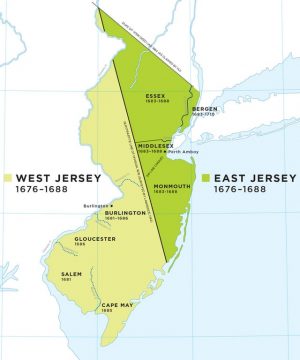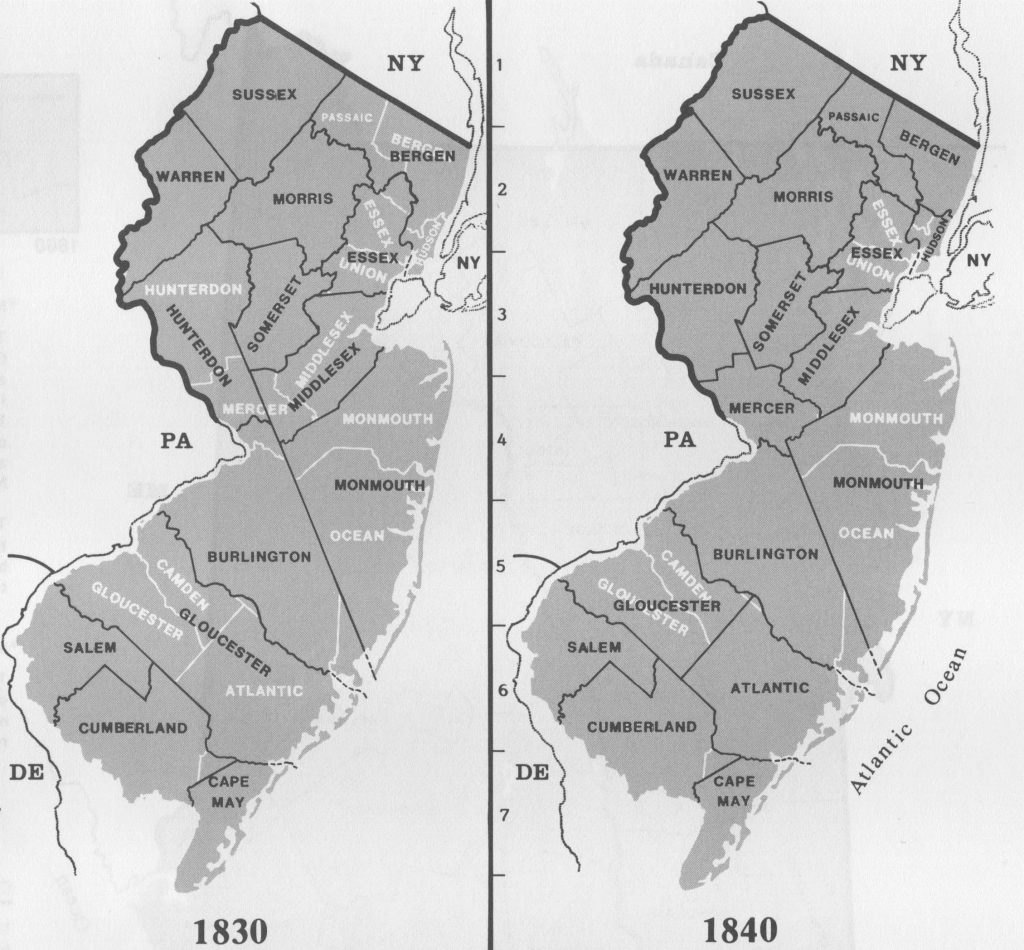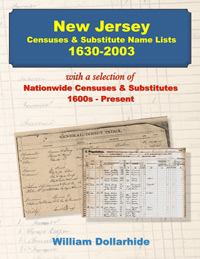The following article is by my friend, Bill Dollarhide, taken from his book, , New Jersey Censuses & Substitute Name Lists, 1630-2003,
Prologue: The highlighted events of this historical timeline for New Jersey are focused on the colonial settlements and subsequent jurisdictional changes that evolved. The goal is to give genealogists a sense of the jurisdictions in place at the time an ancestor lived there. The events include areas near New Jersey inhabited by Dutch, Swedish, English, and finally American settlers, as follows:
1497. Giovanni Caboto, an Italian sponsored by English King Henry VII, explored the Atlantic coast of North America. He claimed the area for the English King, who changed his name to John Cabot in honor of the event.
1524. Giovanni da Verrazano explored the Middle Atlantic region. An Italian hired by the King of France, he sailed past the present New Jersey coast, entered New York bay and reached the Hudson River, then headed north towards present Maine.
1558. Elizabeth I became Queen of England. The earliest explorations of North America took place during her 45-year reign, the Elizabethan Era, or “Golden Age.”
1606. Two joint stock companies were founded, both with royal charters issued by King James I for the purpose of establishing colonies in North America. The Virginia Company of London was given a land grant between Latitude 34° (Cape Fear) and Latitude 41° (Long Island Sound). The Virginia Company of Plymouth was founded with a similar charter, between Latitude 38° (Potomac River) and Latitude 45° (St. John River).
1607. May. Led by John Smith and his cousin, Bartholomew Gosnold, the London Company established the first permanent English settlement in North America – the Jamestown Colony.
1608. English Capt. John Smith of the Jamestown Colony, explored Chesapeake Bay. He was probably looking for crab cakes.
1609. New York. Samuel de Champlain explored the New York area, after dropping down from the St. Lawrence River. He claimed the region as part of New France, and managed to name several places after himself.
1609. Delaware Bay and River. Henry Hudson, an Englishman sailing for the Dutch East India Company, discovered a large bay and river. A year later, Captain Samuel Argall, an English sea captain, named the bay and river after Thomas West, Baron De La Warr, governor of Virginia.
1613. New Amsterdam. A Dutch trading post was set up on lower Manhattan Island. The Dutch discovered that a Swiss Army Knife could buy just about anything from the Indians.
1614. New Netherland Colony. The extensive Dutch claims now included settlements ranging from above present Albany on the Hudson River; then south, to include areas from the Hudson River to the Connecticut River; plus New Amsterdam and much of Long Island. Their claims also extended south of Long Island to the uninhabited areas of present New Jersey, the Delaware Valley, and the shores of Delaware Bay.
1638. Delaware. Dutchman Peter Minuet led a group of Swedes to the Delaware and established Fort Christiana (now Wilmington), the first permanent settlement on the Delaware and the founding of the New Sweden Colony.
1651. Delaware. Peter Stuyvesant, Dutch governor of New Netherland, built Fort Casimir (now New Castle) just a few miles south of Fort Christiana on the Delaware, but the Swedes were no longer getting along with the Dutch and resented the intrusion.
1654. Delaware. The Swedes captured Fort Casimir and renamed it Fort Trinity. A year later the Dutch defeated the Swedes, ending the New Sweden colony, and Delaware became part of New Netherland. But, several Swedish communities continued.
1660. Bergen was established by the Dutch, the first permanent settlement in present New Jersey. At that time, the entire area of present New Jersey was referred to as “Bergen.”
1664. New York. The Dutch colony of New Netherland was taken over by the English after Gov. Peter Stuyvesant surrendered to the British following an “invasion.” About ten Red Coats had marched to Stuyvesant’s house on lower Manhattan, knocked on the front door, when the Governor appeared and handed them his only weapon, a non-functioning dueling pistol. Stuyvesant then asked, “Are you fellows staying for lunch?” The English also took control of the New Jersey settlements from the Dutch with about the same amount of resistance. Soon after these glorious victories, King Charles II granted to his brother, James, the Duke of York, the following: “…the main land between the two rivers there, called or known by the several names of Conecticut or Hudsons river… and all the lands from the west side of Connecticut, to the east side of Delaware Bay.” The area called New Netherland was now named New York.
1664. Delaware. Sir Robert Carr drove the Dutch off the Delaware and claimed the land for James, Duke of York. Delaware then became an English colony.
1665. New Jersey. James, Duke of York, granted to Sir George Carteret and Lord Berkley of Stratton, a part of the New York colony between the Hudson River and the Delaware River.

1674-1676. East Jersey and West Jersey. In 1674, Lord Berkley sold his share to a group of Quakers led by William Penn. Sir George Carteret’s original portion was then named East Jersey. In 1676, the Quaker’s portion was named West Jersey. Still in England, William Penn was now heavily involved in the transportation of Quakers to the West Jersey Colony. He was a trustee in the colony’s establishment, and was responsible for drawing up the first set of laws. They would become the basis for the Great Experiment he envisioned for Pennsylvania a few years later. Map source: www.reddit.com.
1674. The Treaty of Westminster ended hostilities between the English and Dutch and officially returned all Dutch colonies in America to the English. This ended the official Dutch presence in North America – but many of the Dutch settlements continued under English rule, particularly along the Hudson River of New York, and in and around Bergen, East Jersey.
1681. Pennsylvania. William Penn was granted land in North America by Charles II to establish the colony of Pennsylvania. He arrived in October 1682 on the ship Welcome. He visited Philadelphia, just laid out as the capital city, and soon after his arrival, summoned a General Assembly, called for uniting Delaware with Pennsylvania, and created the first three Pennsylvania counties of Bucks, Chester, and Philadelphia.
1682. Delaware. James, the Duke of York, transferred control of the Delaware Colony to English Quaker William Penn.
1702. Province of New Jersey. East and West Jersey were combined into one colony again. The two proprietors appointed a governor for the Province of New Jersey, but retained independent land management for both East New Jersey and West New Jersey. Thereafter, the two original land offices remained intact under the administration of Land Commissions, for the purpose of selling land to individuals. Both commissions still exist today.
1707. During the reign of Queen Anne, the United Kingdom of Great Britain was established after the Union with Scotland Act passed the English Parliament in 1706; and the Union with England Act passed the Parliament of Scotland in 1707. The English Colonies now became the British Colonies.
1763. Treaty of Paris. The French and Indian War ended. Great Britain gained control of all lands previously held by France west of the Mississippi River, which became the dividing line between British North America and New Spain.
1776-1783. Revolutionary War. The 1783 Treaty of Paris ended the war, and the United States of America was officially recognized as an independent nation by Britain, France, and Spain.
1787. Dec. 12. New Jersey became the 3rd state to join the Union just a few hours after Pennsylvania.
New Jersey Censuses and Substitutes:
1780s-1840s. New Jersey Ratable Lists. From the late 1700s through the early 1800s, numerous tax lists were prepared at the county level in New Jersey. A person named in one of these assessment lists of county residents was called a “ratable.” Many of the original Ratable Lists are now at the New Jersey State Library. After the NJ Federal and State Censuses, the NJ Ratable Lists probably provide the next best chance of finding a lost ancestor in New Jersey.
1790, 1800, 1810 & 1820 New Jersey Federal Censuses. The first four federal censuses taken in New Jersey were lost (the most for any state).

1830-1840 Federal Census Years. The 1830 map above shows the 14 counties of New Jersey at the time of the 1830 Federal Census. New Jersey’s first four Federal Censuses, 1790-1820, were lost. The only difference in county boundaries between the years 1790 and 1830 was the addition of Warren County, taken from Sussex in 1824. The 1840 map above shows the 18 counties of New Jersey at the time of the 1840 Federal Census. Counties formed after 1840: Camden County, taken from Gloucester in 1844; Ocean County, taken from Monmouth in 1850; and Union County, taken from Essex in 1857. Map source: Map Guide to the U.S. Federal Censuses, 1790-1920.
1850-1880 & 1900-1940. New Jersey Federal Censuses are complete for all counties. The 1890 census for all states was lost in a fire.
1855-1915. New Jersey State Censuses: For the purpose of apportionment of its General Assembly, New Jersey began taking state censuses in 1855. They continued every ten years thereafter until the last one in 1915. The 1855 and 1865 censuses have some missing counties, but cover most of the state. The worst losses are for the 1875 census, which has just three counties with name lists. The 1885 through 1915 censuses are complete for all counties. All of the extant census originals were microfilmed by the NJ State Archives and copies are available elsewhere, including the FHL library in Salt Lake City.
NJ State Censuses Online:
– Ancestry.com used the microfilm to create a digitized index to the 1885, 1895, 1905, and 1915 NJ State Censuses. Visit Ancestry’s New Jersey Family History Page for any updates.
– FamilySearch.org has done the same for the 1855, 1865, 1885, 1895, 1905, and 1915 NJ state censuses. Visit FamilySearch’s New Jersey Indexed Historical Records Page for any updates. A partial 1885 online searchable index is available at the NJ State Archives website. See 1885 State Census – Passaic County and Atlantic City for the search screen.
Further Reading:
New Jersey Censuses & Substitute Name Lists, 1630-2003 (Printed Book),softbound, 79 pages, Item FR0269.
New Jersey Censuses & Substitute Name Lists, 1630-2003 (PDF eBook), 79 pages, Item FR0270.
Online New Jersey Censuses & Substitutes: A Genealogists’ Insta-Guide TM, 4-page, laminated, 3-hole punched, Item FR0339.
Online New Jersey Censuses & Substitutes: A Genealogists’ Insta-Guide TM (PDF version), 4-page, Item FR0340.
